The world is a canvas painted with locations that contain mind-expanding landscapes, each offering unique insights into the history and splendor of their respective region. These landscapes transcend the ordinary, reaching heights of grandeur and wonder that floor the human mind. As we embark on a journey to some of the most remarkable corners of the Earth, we will discover various locations of exceptional beauty, their geological significance, cultural richness, and the amazing creatures that call them home. While we won’t be covering all of the Earth’s incredible locations and landscapes, this list will highlight a select handful from around the world.
1. Machu Picchu in Peru
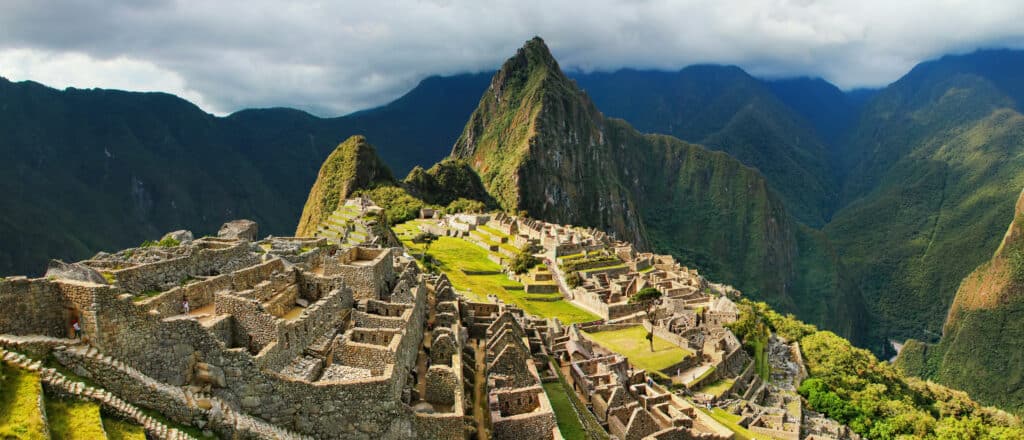
The ancient Incan city in Peru, Machu Picchu, is a world-renowned archaeological wonder.
©Don Mammoser/Shutterstock.com
First on our list of locations with mind-expanding landscapes is Machu Picchu. High in the Andes Mountains of Peru, Machu Picchu is a world-renowned archaeological wonder left behind by the Inca Empire. This ancient citadel shows the Incan people’s remarkable engineering talent and culture. This mind-expanding location is perched on a ridge above the Urubamba Valley, or Sacred Valley, approximately 7,970 feet (2,430 meters) above sea level. Its precise location resides in southern Peru on the Eastern Cordillera.
Machu Picchu’s landscape is characterized by its dramatic setting. Surrounded by lush green peaks and cliffs, this mountaintop marvel offers panoramic views of the surrounding Andes. An awe-inspiring feature of Machu Picchu is how it seamlessly integrates with its natural surroundings. The stone structures, terraced fields, and intricate water management systems blend harmoniously with the rugged terrain.
One of the iconic animals in the Machu Picchu area is the Andean bear or spectacled bear. This common yet incredible species inhabits the landscape of Machu Picchu. Additionally, a variety of bird species, such as the Andean condor, are found soaring above in the skies, adding to the area’s natural beauty.
The general landscape’s geological features include the stunning Huayna Picchu peak, adjacent to Machu Picchu itself. It offers a challenging hike and equally breathtaking vistas. The Temple of the Sun, Intihuatana stone, and the agricultural terraces are architectural wonders that enhance the grandeur of this location’s mind-expanding landscape.
Machu Picchu’s ability to transport visitors to the distant era of this region, its awe-inspiring natural surroundings, and its remarkable historical significance make it one of the world’s most spectacular landscapes.
2. Mount Everest in Nepal and Tibet
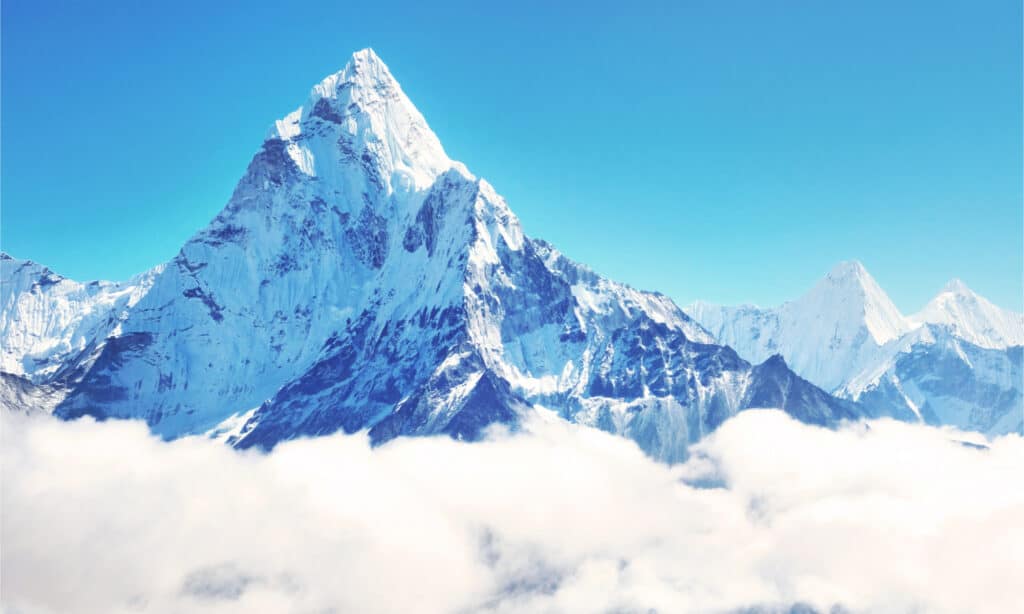
One of the tallest mountains in the world is Mount Everest.
©Vixit/Shutterstock.com
Mount Everest, one of the world’s tallest mountains, is a behemoth on the border between Nepal and the Tibet Autonomous Region of China. Its precise location is in the Himalayas, in the Mahalangur Himal sub-range.
The landscape of Mount Everest is nothing short of exceptional. This colossal mountain rises to an astonishing height of 29,032 feet (8,849 meters) above sea level. Its snow-covered summit pierces the heavens, and the surrounding Himalayan peaks create an out-of-this-world panoramic view. The Khumbu Glacier, one of the largest glaciers in Nepal, snakes its way through the landscape surrounding Mount Everest and makes a harrowing start to mountaineering expeditions of the mountain.
The landscape has extreme altitudes, frigid temperatures, and unpredictable weather patterns. Mount Everest’s south side is a common summit route that is arguably slightly safer than the mountain’s north side. The mountain’s geological features result from its formation brought on by the collision of the Indian and Eurasian tectonic plates roughly 60 million years ago.
Unique animals, such as the elegant snow leopard and the Himalayan tahr, inhabit the region. These animals have adapted to the harsh alpine and subalpine environments.
Mount Everest’s allure lies not only in its sheer height but also in the spirit of human exploration and determination it embodies. Climbers and mountaineers worldwide embark on the arduous expedition to reach its summit, an example of the indomitable human spirit in the face of nature’s grandeur. Unfortunately, this popularity and increase in adventurous tourism has caused concern due to littering, exploitation of Sherpas, and an increasing death toll. The mountain has become so overpopulated due to mountaineering expeditions that there is often a queue of people waiting to summit the peak.
3. The Great Ocean Road in Australia
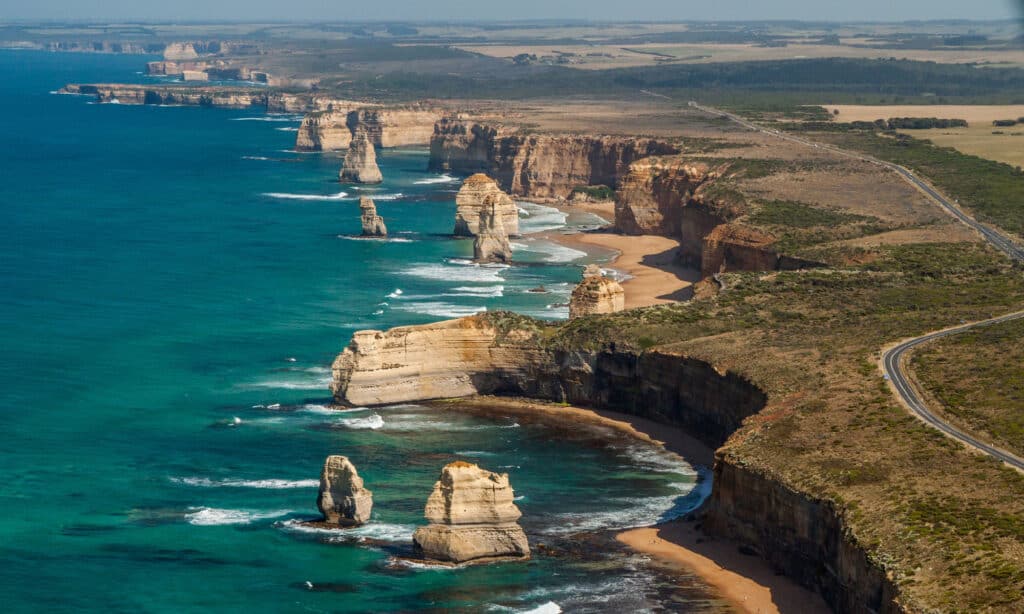
In Australia, the Great Ocean Road is a spectacular coastal drive along the southern coast of Victoria.
©iStock.com/RubyRascal
Next on our list of locations with mind-expanding landscapes is the Great Ocean Road. The Great Ocean Road in Australia is a spectacular coastal drive along the southern coast of Victoria. It stretches for approximately 150 miles (240 kilometers), starting near the city of Torquay and ending in the town of Allansford. Moreover, the Great Ocean Road is listed on the Australian National Heritage List.
The dramatic meeting of land and sea makes the Great Ocean Road landscape genuinely incredible. Along this scenic route, travelers experience breathtaking views of the Southern Ocean, rugged cliffs, and stunning rock formations. The most iconic of these formations is the Twelve Apostles, a collection of limestone stacks rising impressively from the ocean.
Furthermore, this extensive landscape features towering sea cliffs, pristine beaches with world-class surf, and lush rainforests that starkly contrast the ocean’s deep blue waters. The limestone and sandstone formations, continuously sculpted by the forces of erosion, create a sense of wonder and awe.
Unique wildlife thrives in this coastal environment, including koalas, kangaroos, various bird species, and even glowworms, which you can view at Melba Gully State Park, amongst other places. The region is also known for its whale-watching opportunities, with southern right whales, blue whales, and humpback whales migrating along the coast.
4. The Highlands of Iceland

Iceland is home to some of the most diverse landscapes in the world.
©Creative Travel Projects/Shutterstock.com
You can find the Highlands of Iceland within the interior of Iceland, an enchanting and otherworldly landscape approximately 1,000 to 1,300 feet (300 to 400 meters) above sea level. This vast region occupies the central portion of Iceland. Moreover, the remote and rugged terrain consists of lava fields and basalt mountains, and the soil is mainly volcanic ash.
Furthermore, the landscape of the Icelandic Highlands is mind-expanding due to its stark contrasts and surreal features. Here, you’ll encounter vast lava fields, geothermal wonders, glaciers, volcanoes, and colorful rhyolite mountains. Landmannalaugar, residing in the Southern Highlands, showcases numerous steaming hot springs against a backdrop of multicolored mountains, creating a surreal and breathtaking scene.
One unique animal in the Highlands is the Arctic fox, which has adapted to the harsh Icelandic environment. The region is also a habitat for various bird species, including the ptarmigan and the gyrfalcon.
The geological features of the Icelandic Highlands have a violent history. It lies atop the Mid-Atlantic Ridge, where the North American and Eurasian tectonic plates meet. This geological activity has shaped the landscape with rugged lava fields, deep valleys, and many towering volcanoes. Other notable and incredible features of the Highlands include the Fagrifoss waterfall, Hveradalir, Lakagígar, Torfajökull, Þórsmörk, Herðubreið, Eldgjá, and Askja.
The Highlands’ remote and pristine nature has led to its designation as a protected area, ensuring the conservation of its unique features. It’s a landscape where visitors can connect with the raw power of nature and experience the Earth’s geological forces in action.
The Highlands of Iceland epitomize the concept of otherworldly landscapes, where the juxtaposition of geological wonders and untamed wilderness creates a truly spectacular and unforgettable experience.
5. Santorini in Greece
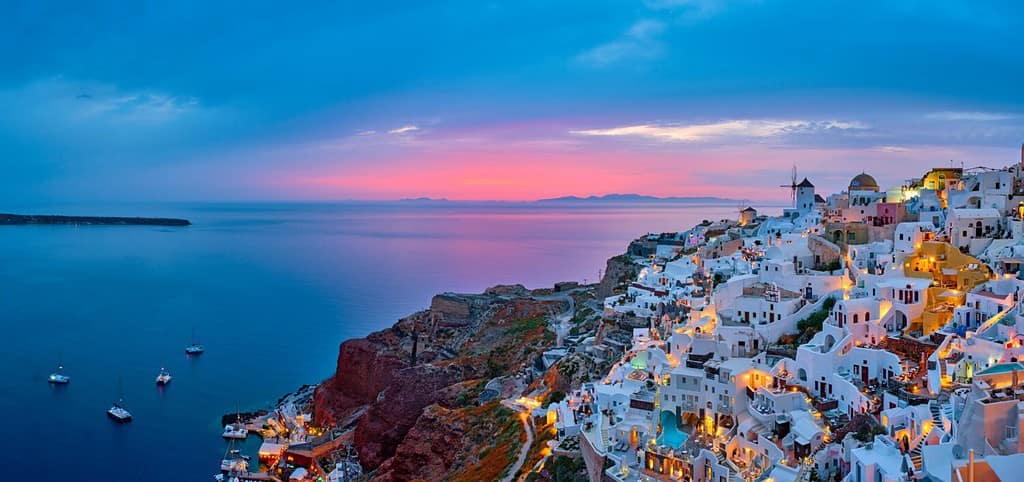
Amongst the Greek islands, Santorini is a divine location with a stunning landscape.
©Dmitry Rukhlenko/Shutterstock.com
Next on our list of locations with mind-expanding landscapes is Santorini. Santorini, a Greek island in the southern Aegean Sea, is part of the Cyclades archipelago in Greece. This stunning location is precisely situated in the southernmost part of the Cyclades group. Moreover, it is approximately 125 miles (200 kilometers) southeast of the mainland of Greece.
What makes Santorini genuinely incredible is its unique geological history. Santorini is essentially the remnants of various volcanic activity. The island was born from layers of lava produced by overlapping shield volcanoes, in addition to experiencing three significant eruptions, one of which was the Minoan eruption, which caused magma chambers to collapse. This resulted in a large caldera. Moreover, this all occurred around 3,600 years ago.
The crescent-shaped island features towering cliffs that drop sharply into the deep blue waters. Moreover, one of the iconic features of Santorini’s landscape is the picturesque whitewashed buildings perched on the cliffside, particularly in the town of Oia. These buildings, with their blue accents, create a stunning contrast against the natural landscape.
Santorini’s unique geography has also given rise to its famous sunsets, often described as some of the most beautiful in the world. As the sun dips below the horizon, the sky and sea are painted with vibrant shades of yellow, orange, red, pink, purple, and blue.
Santorini is home to various bird species, such as seagulls, rock doves, house sparrows, and pigeons, that thrive in the island’s coastal environment. Additionally, a diverse range of marine life inhabits the waters around Santorini, including moray eels, octopuses, and many crustaceans and other fish. It is an exceedingly popular destination for swimming, snorkeling, and diving.
6. Salar de Uyuni in Bolivia

The largest salt flat in the world, Salar de Uyuni, is an other-worldly landscape.
©iStock.com/shinnji
In southwest Bolivia, Salar de Uyuni is the world’s largest salt flat. It resides within the Daniel Campos Province in the Potosí department. Moreover, it covers an area of approximately 4,086 square miles (10,582 square kilometers).
The landscape of Salar de Uyuni is nothing short of surreal. It is a vast expanse of blindingly white salt crust that stretches as far as the eye can see. During the rainy season, a thin layer of water often covers the salt flat, creating the world’s largest natural mirror. This mirror effect reflects the sky and clouds, giving the illusion that you are walking on a seemingly endless, perfectly reflective surface.
The salt flat’s unique features include hexagonal patterns on the salt crust caused by the crystalline structure of the salt. In addition to the salt flats, the area surrounding Salar de Uyuni is dotted with mountains, some of which are home to unique plant species that thrive in this arid landscape of the Altiplano.
Wildlife in the region includes the Chilean flamingos, Andean flamingos, and rare James’s flamingos that inhabit the area during the breeding season, as well as Andean foxes, or culpeo, and vicuñas that roam the surrounding landscape.
7. Banff National Park in Canada
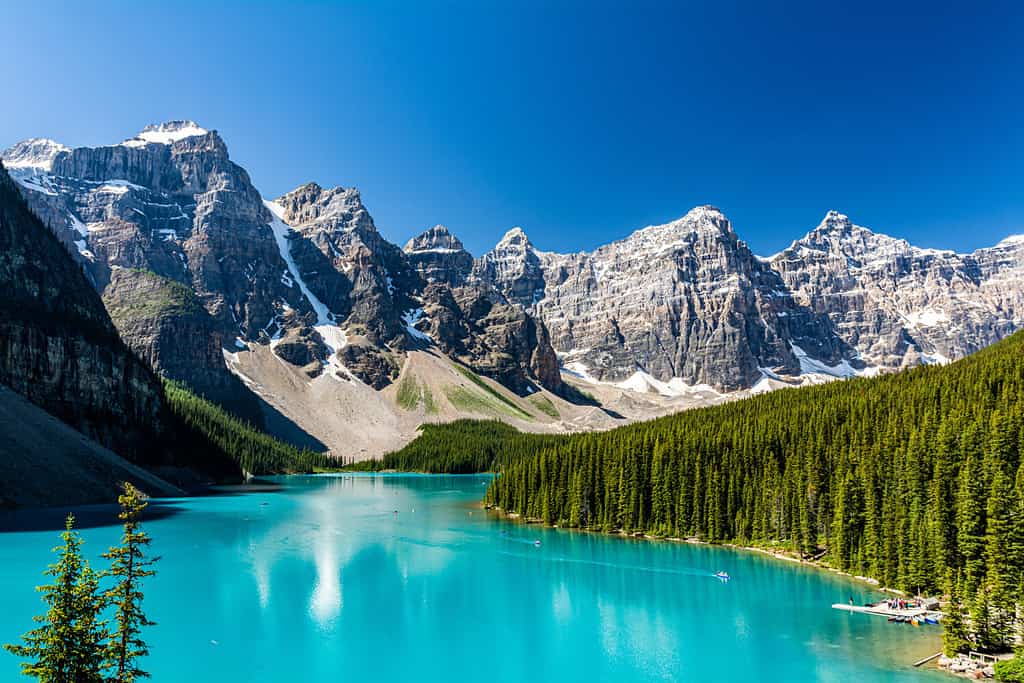
Canada’s oldest national park is Banff National Park.
©Kabindra shrestha/Shutterstock.com
Next on our list of locations with mind-expanding landscapes is Banff National Park. As Canada’s oldest national park, Banff National Park resides in the Canadian Rockies of Alberta, Canada. It is another natural wonderland that showcases the majestic beauty of the Canadian wilderness. It resides in the southwestern part of Alberta, near the town of Banff. Moreover, it encompasses approximately 2,564 square miles (6,641 square kilometers).
The landscape of Banff National Park is a picturesque beauty boasting part of the boreal forest. Towering mountain peaks, crystal-clear lakes, glaciers, and dense pine, spruce, fir, and larch forests characterize it. Two of the park’s iconic features include Moraine Lake and Lake Louise, with brilliant turquoise waters surrounded by snow-capped peaks. Both offer a scene of unparalleled natural beauty in this region of North America.
The park’s rugged terrain includes stunning geological formations such as the Hoodoos. These are tall, thin spires of rock carved by erosion. The Columbia Icefield, located within the Banff National Park and Jasper National Park, feeds several major glaciers. This includes the Athabasca Glacier. The various glaciers are a remarkable feature of the region’s landscape.
Banff National Park is home to iconic Canadian wildlife, including grizzly bears, black bears, elk, plains bison, moose, and wolves. These animals roam freely in the park’s pristine wilderness. This location is truly a haven for nature enthusiasts of all backgrounds and interests.
The park’s significance goes beyond its natural beauty. It is part of the Canadian Rocky Mountain Parks World Heritage Site. Banff’s conservation efforts ensure this extraordinary landscape remains protected and accessible for generations.
8. Fiordland National Park in New Zealand
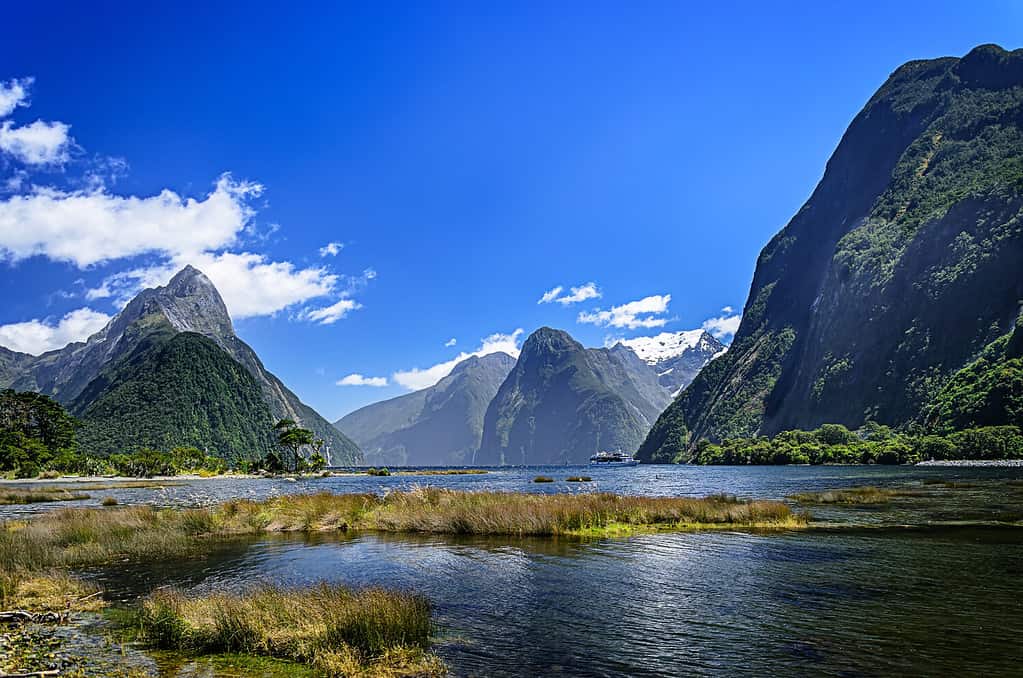
Some of the most iconic scenes in Lord of the Rings were filmed in Fiordland National Park.
©Katarina S/Shutterstock.com
Fiordland National Park resides on New Zealand’s South Island. It is a pristine wilderness area that epitomizes the country’s stunning natural beauty. Moreover, it is situated in the southwestern part of the South Island. The park is part of the Te Wahipounamu World Heritage Site.
The landscape of Fiordland National Park contains earthly wonder and fantasy. The park has deep fiords, lush rainforests, towering waterfalls, and jagged mountain peaks. Fiords like Milford Sound and Doubtful Sound are some of the park’s most iconic features, with their sheer cliffs rising dramatically from the water.
One unique characteristic of Fiordland is its significant annual rainfall, making it one of the wettest places in New Zealand. This rainfall feeds numerous waterfalls that cascade down cliffs, adding to the park’s breathtaking beauty.
The park is home to a range of wildlife, including native New Zealand birds like the kea, tui, and kaka. The rare and endangered Fiordland crested penguin also makes its home in this region. You may spot seals, dolphins, and whales, such as the southern right whale, in the waters surrounding the fjords.
Fiordland National Park’s remote and rugged landscape offers a sense of isolation, tranquility, and grandeur. The lush forests, pristine lakes, and dramatic fiords create a mind-expanding experience. All of which are immersed within the raw and unspoiled beauty of New Zealand’s wilderness. Furthermore, this spectacular landscape contains many filming locations from the Lord of the Rings films.
9. Bora Bora of French Polynesia
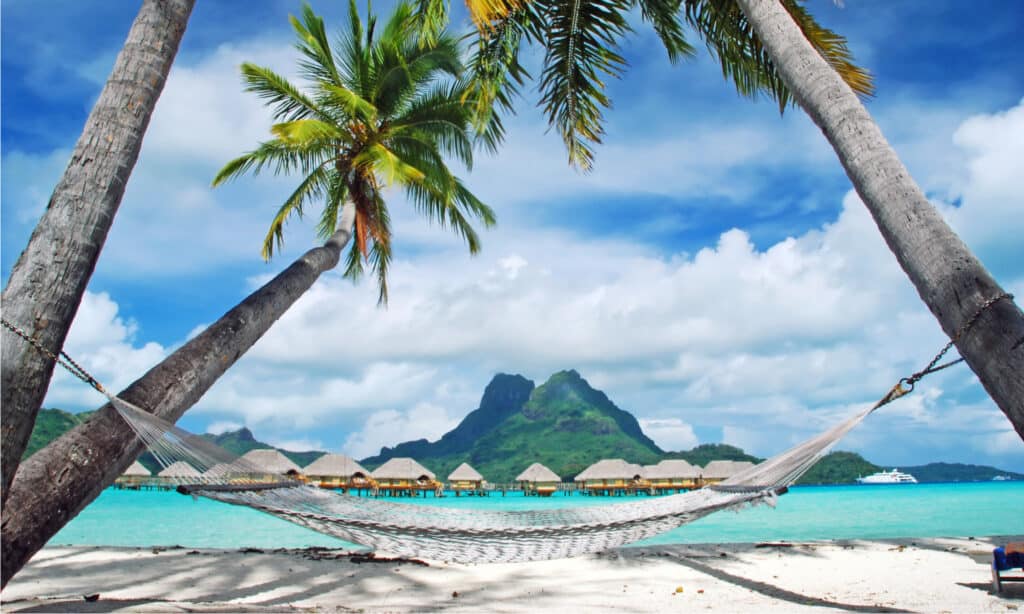
Part of Leeward Island, Bora Bora is a stunning tropical location with an exotic landscape.
©wilar/Shutterstock.com
Next on our list of locations with mind-expanding landscapes is Bora Bora. Bora Bora, known by its native name, Pora Pora, is a unique jewel in the South Pacific. It is part of French Polynesia, situated in the Pacific Ocean. Moreover, this small island resides within the Leeward Islands, which consist of the western part of the Society Islands archipelago. Bora Bora is relatively small, with a surface area of 19 square miles (31 square kilometers). However, the landscape of Bora Bora consists of stunning turquoise lagoons and an expansive barrier reef encircling the lush island and its verdant peaks. The iconic images of Bora Bora usually contain one of its two dormant volcanoes. This includes Mount Pahia and Mount Otemanu, which rise dramatically from the island, creating a stunning backdrop to the dazzling waters.
The island’s coral reefs are a prominent feature, providing vibrant underwater ecosystems with a kaleidoscope of marine life. The crystal-clear waters allow for exceptional visibility, making Bora Bora a world-famous destination for snorkeling and scuba diving.
Unique animals found here include the blacktip reef shark and the lemon shark, which inhabit the lagoon. Bird enthusiasts can spot seabirds such as the frigatebird and the red-tailed tropicbird.
The overwater bungalows that dot the lagoon, with their direct access to the warm, azure waters, add to the island’s experience. Bora Bora’s blend of natural beauty and luxurious accommodations makes it an unparalleled destination for those seeking an exotic experience.
10. Pamukkale in Turkey
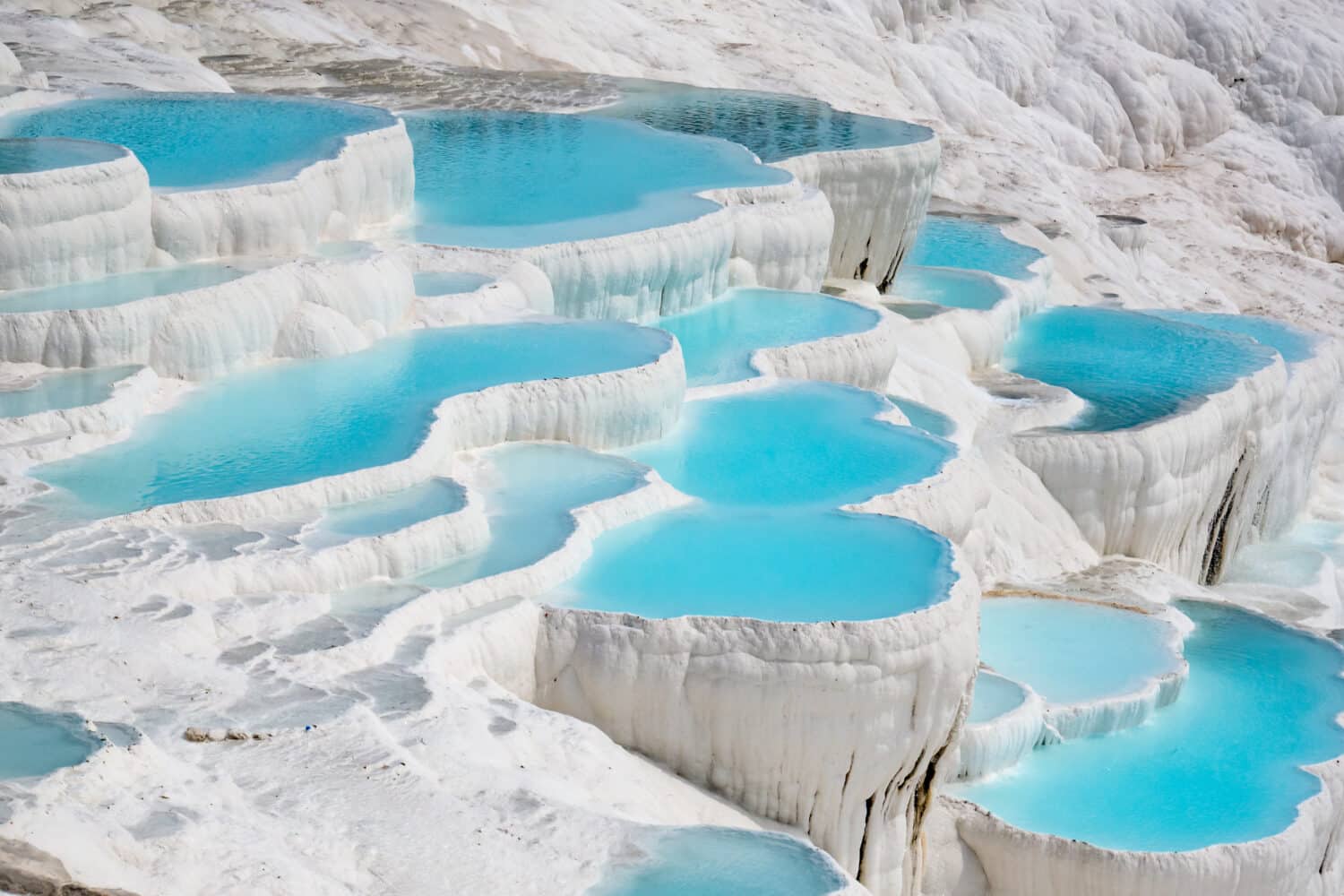
In Turkey, Pamukkale is a landscape from another planet.
©Andre Chet/Shutterstock.com
Pamukkale is located in southwestern Turkey within the Denizli Province. It is a natural wonder with stunning terraces of white mineral-rich thermal waters. Moreover, the Turkish meaning of Pamukkale is “cotton castle,” which aptly describes the landscape.
Residing in the River Menderes valley, this surreal and captivating landscape appears foreign to our planet. The terraces of Pamukkale consist of carbonate minerals left behind by the flow of mineral-rich thermal waters cascading down the mountainside over thousands of years.
Furthermore, the terraces consist of travertine, a sedimentary rock, specifically terrestrial limestone, deposited by the thermal waters. These terraces appear as if they are frozen waterfalls. Their brilliant white terraces, bright blue waters, and contrasting lush green surroundings are truly a one-of-a-kind sight.
The terraces are mineral-rich pools or hot springs. People have used these pools for centuries for their therapeutic properties. It is a popular destination for visitors looking to relax and rejuvenate in a divinely unique landscape.
Various bird species inhabit the area around Pamukkale, such as swallows and sparrows. Additionally, the nearby ancient city of Hierapolis, an ancient Roman spa city, offers a historical dimension to this already mesmerizing landscape.
11. Torres del Paine National Park in Chile
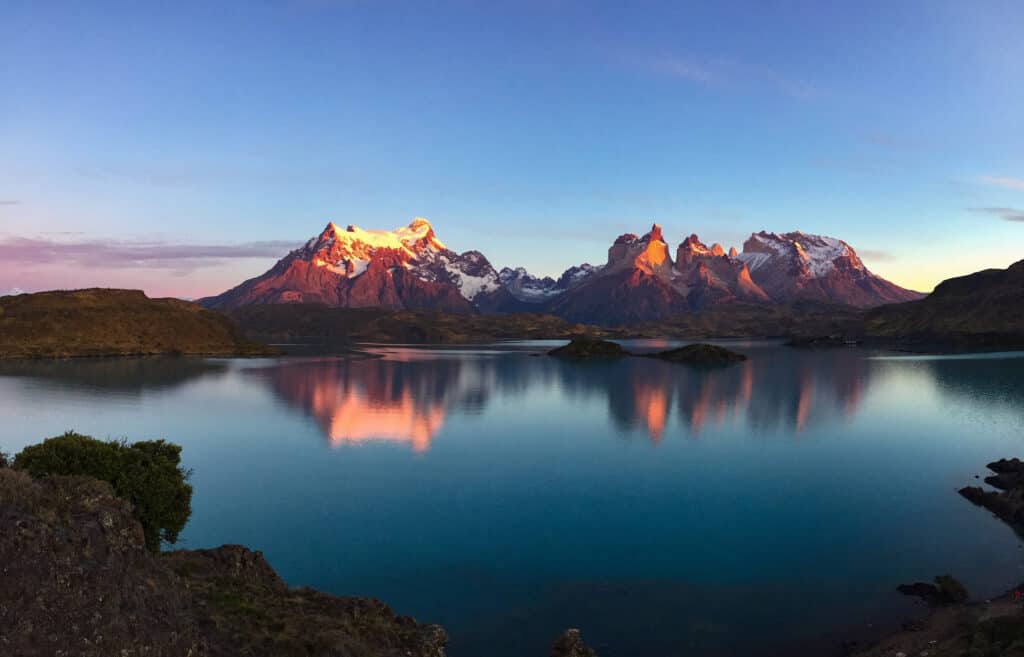
The Torres del Paine National Park in Chile is home to the iconic Cordillera del Paine.
©iStock.com/Christian Peters
Last on our list of locations with mind-expanding landscapes is Torres del Paine National Park. Torres del Paine National Park is located in the southern Chilean region of Patagonia. It is a wilderness wonderland that showcases the raw beauty of the region. The park encompasses approximately 700 square miles (1,800 square kilometers).
Torres del Paine National Park is home to some of the most striking glaciers, mountains, lakes, and rivers. Towering granite spires, including the iconic Cordillera del Paine, a mountain group, rise majestically from the landscape, creating a breathtaking vista. These spires, sculpted by glacial activity wearing down sedimentary layers, are among the park’s most iconic features.
The park also boasts pristine turquoise lakes. Two include Lake Pehoé and Lake Nordenskjöld. Rugged mountains and lush forests surround these lakes. Moreover, their shores provide some of the best photographic scenes in the park. The Grey Glacier, one of the park’s major glaciers, adds to the stunning scenery with its rugged presence.
The unique wildlife of Torres del Paine includes the guanaco, a wild relative of the llama. The landscape is also home to foxes, pumas, and a variety of bird species, such as the Andean condor and the Magellanic woodpecker.
The park’s rich geological history has lasting evidence of ancient glaciers and tectonic activity. Visitors can explore over 60 different trails that lead to viewpoints offering intimate and panoramic views of this pristine wilderness.
Torres del Paine National Park is not only a paradise for hikers and adventure seekers but also a sanctuary for those seeking unique solitude amidst some of the Earth’s most breathtaking landscapes. Its remoteness and untouched beauty make it a must-visit destination.
The photo featured at the top of this post is © iStock.com/shinnji
Thank you for reading! Have some feedback for us? Contact the AZ Animals editorial team.







